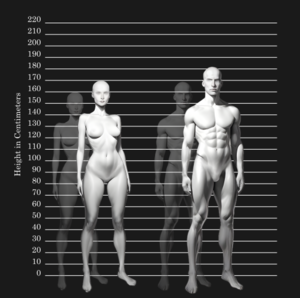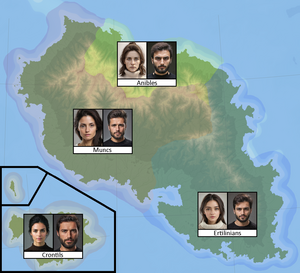Brucht
| Ethnic group | |||
|---|---|---|---|
 ' | |||
| Height comparison | |||

| |||
| Eye colour |
| ||
| Hair colour and type |
| ||
| Total population | |||
| Location map | |||

| |||
| Regions with significant populations | |||
| Languages | |||
| Religions | |||
| Related ethnic groups | |||
| Aldsay, Tragoni | |||

The Brucht are a Anario-Jorven ethnic group originating in Nestor.
Etymology
The endonym Brucht, used for the people group comes from the Achlt word for Break(er) referring to their warrior culture. The warrior of Nestorian culture emphasize breaking the enemy's lines or breaking their will. The Brucht were (sometimes still are) known for their aggressive and decisive tactics in warfare, aiming to shatter enemy formations and morale. The term "Breaker" also symbolize the Brucht people's ability to overcome challenges and "break through" obstacles. This reflects their resilience in battle, their determination to resist invaders, and their ability to endure harsh conditions on the island (like during warring lords period and the nature on the Anibar Coast). The name embodies the idea that they are not just survivors but conquerors of any hardship that comes their way.
The name Brucht is a combined name for the four ethnic groups in Nestor: Ertilans, Muncs, Crontils and Anibles. The differences between these four groups are not large but they can still be seen as separate ethnic groups.
History
Early History
Both anthropologists and archaeologists concluded that the Brucht along side with numerous Anarian groups came from a shared proto-Anarian lineage that branched out in Davai roughly 60,000 years ago. These Anario-Jorveh embarked on a journey, moving from Davai to southern Jorveh and subsequently reaching northern Anaria. Here, they came into contact with the Aurir, believed to be early Wolgos. At the same time, the Anario-Tharnians traveled through Tharna, traversing Anaria Minor and entering eastern Anaria around 30,000 years ago. In regions like Thultania and northern Anaria Major, these migration paths split up.
Within a span of ten millennia, the Anario-Jorveh culture, characterized by its agropastoral way of life, held sway over territories ranging from Jorveh to the southern fringes of Adhem. A subsequent shift occurred around fifteen thousand years ago when the agrarian Anario-Biazriite culture surged northwards from Adhem, gaining prominence across northeastern Versia and advancing into regions such as the Helreich, Calcit, and Golden Peninsulas. In the next 5,000 years, this culture radiated throughout Anaria, laying the foundation for the Brucht in Nestor, the Dolmer in eastern Stoldavia, the Cheltai in Livaria, the Cheltic Isles, and eastern Anaria Major, the Emther in Thultain, and the Karsk in western Anaria Major.
History on Nester Mayor
The Brucht people arrived in modern day Nestor around the year 3000 RH from North-Eastern Stoldavia via the Skyfaldso island. The early Brucht people moved south of the main island of Nester Mayor with the first evidence found in the modern state of Juncor. The first evidence of agriculture found in the south of the island in Erinor, near the modern city Elcin (historically known as Erapo). The people were devided on the island until 6385 RH when via Tragoni traders Erecund was introduced to the people. The city of Elcin grew into an empire eventually controlling the island from 6450 RH until 6850 RH under the Erinic Empire. The Erinic Empire closed its borders in fear of the Orkanan religion only keeping the borders open to the Tragoni. The strong connection with the Tragoni never went away causing them to leave their mark on the Brucht people via the religion, language later on military.
Around 6780 RH there was a large war between Erecund and Orkanan causing the three holy tablets of Erecund stored in Atregonia to be in danger of being captured and destroyed. In order to protect the holy tablets, the Tragoni agreed to move the tablets to the holy temple in Elcin. The island of Nester Mayor became a refuge for Erecund people because of the reputation of being hard to invade.
In 6850 RH the Erinic Empire faced severe stability problems and exploded the island into hundreds of Herdoms. The Herdoms fought many deadly wars with each other which also caused a population stagnation for a extended period of time. However the Herdoms all had a mutual agreement to defend the island against any invaders from anywhere but the island itself. Because of the constant wars and the warrior culture, the armies of the Herdom were a forced to reckoned with. Nations on the mainland of Stoldavia tried to invade but it failed badly and the island was given the nickname Breakers referring to their small yet powerful armies. One of the reasons for the strong small armies was the way war was used to have natural selection, creating few yet dangerous warriors. The constant wars on the island shaped the culture of the island until this day without the natural selection process by surviving a deadly battle.
The island slowly started uniting between 7400 and 7450 RH but the island wouldn't be fully unified until 7563 RH, over a hundred years later.
Anatomical and biological characteristics
The Brucht people have isolated from the main Anarian people from 3000 RH to ~7400 or 4400 years. The isolation was caused by the Brucht people being hostile towards anyone who was not part of the ethnic group. The only other ethnic group that entered the island in this period was the Tragoni but the sharing of genetic material was minimal. Due to this isolation, the Brucht people have distinct features.
Over the 4400 years of years of adaptation, they have undergone minor physical changes that made them different from other ethnic groups. The Brucht people have adapted to their enviroment which is wet temperate climate. The evolution in the latter part of the isolation period was caused by natural selection caused by war. Most of these wars happend in the region now occupied by the Ertilans and Muncs.
Body
Nestorians are of medium height on average, with men displaying broader shoulders standing at 182 cm and women characterized by a more slender, petite build standing at 170 cm.
Skin texture
Nestorian women are renowned for their exceptionally soft and smooth skin. This trait is attributed to a combination of genetics, a higher subcutaneous fat layer, and the humid climate, which promotes moisture retention. The use of native plant-based salves, such as Burr Tree Oil and Grass Salve, further enhances this quality, making soft skin a celebrated beauty standard. In contrast, Nestorian men have tougher, more rugged skin, a reflection of their roles in physical labor and exposure to the elements. Their skin is naturally resilient and requires minimal care to withstand the challenges of the environment. Their skin is also thicker due to higher rate of survival in battle.

Hair
Nestorians typically have dark hair that offers natural protection against the sun. Women often possess shinier hair, a result of their dietary habits.
Eyes
Their almond-shaped eyes, commonly in shades of brown, hazel or black, are striking. Larger eyes are more prevalent among women, contributing to their heightened emotional recognition and empathetic demeanor. Furthermore, black eye color is quite dominant amoung the Ertilans at 42%. The eyes are technically very dark brown and not black. The black color is a result of melanin overproduction in the iris. People with these black eyes more sensitive to light due to less effective lacking a proper iris response and this causes bright lights to be rare in Nestor. Some people also have enhanced vascular visibility due a thin scleral tissue combined with heightened vascularization in the eye but this variant is much more rare, even among Ertilans (1,6%). Another small population at about 0,02% also has melanin overproduction in their sclera causing the entire eye to be black. These people need to wear eye protection in most light conditions.
The overall sensitivity to light for mostly Ertilans has been used againt them in times of conflict due to enemies shining light at them or the lack of lighting in their living places. Against fauna, this is not really a problem because there are not predators that pose a threat to humans on Nestor besides other humans. Nestorian have used a pet bird to help see them in the dark like the Nestorian owl and the Nestorian night hawk.
People with any variant of black eyes are often seen squinting to protect their eyes from the light. This distinctive gaze that often appears as being angry or imposing.
Genetic and Environmental Adaptations
The "Astikel" gene, unique to Nestorians, regulates collagen and elastin differently between genders, leading to the contrasting skin textures in men and women. Their adaptation to the temperate-savanna climate includes excellent moisture retention, aiding comfort during both rainy seasons and dry spells. A diet rich in omega-3 fatty acids, vitamin E, and antioxidants, derived from local fish, burr oak nuts, and fruits, plays a critical role in maintaining their health, skin, and hair quality.
Communcation
Nestorian (Brucht) communication is characterized by its extreme directness and a unique reliance on verbal clarity and hand movements. Non-verbal cues, such as facial expressions and subtle body language, play a much smaller role in daily interactions, especially among men, who often struggle to interpret these cues. This distinction has given rise to a deeply embedded cultural practice of combining spoken language with hand gestures to enhance communication precision.
Sign language predates spoken language among Nestorians. For a long period, sign language was the primary means of communication, with vocal noises complementing it. This combination created a rich and deep communication style. Spoken language does not come as naturally to Brucht (Nestorian) people, and some isolated groups in Nestor still rely exclusively on sign language. This has historically led the SOC to label the island as primitive, even though the majority of Nestorians developed spoken language around 2000 years ago.
Nestorian sign language has its roots in practical contexts such as hunting, warfare, and other high-stress situations where verbal communication was difficult or dangerous. Over generations, this reliance on hand signals influenced the broader communication style of Nestorians, leading to a reduced emphasis on non-verbal subtleties, particularly in male social interactions. Men, in particular, incorporate hand gestures into their speech so extensively that it can appear almost as a secondary language layered over their verbal expressions. Women, while also familiar with sign language, tend to maintain a more traditionally human reliance on non-verbal cues such as facial expressions and tone of voice.
A notable feature of Nestorian conversation is the frequent use of hand signs to indicate emotions or emphasize key points. During discussions, it is common to see someone verbally expressing a thought while simultaneously making a hand gesture representing their emotional state, ensuring that their message is received as intended. In more casual settings, the combination of speech and sign language is common, though in official settings, it is generally avoided. However, in the military, sign language remains the norm among soldiers. A respected gesture known as the Nestorian Salute is used to honor fallen soldiers or esteemed individuals.
Verbal communication itself is marked by a blunt, unfiltered, and highly direct style. Nestorians are known for their candidness and often disclose personal information that outsiders might consider inappropriate or overly intimate. This tendency to ‘overshare’ is not viewed as indiscretion but rather as a cultural marker of trust and openness. It is important to note that this directness does not extend to matters of secrecy or critical information—Nestorians are adept at protecting sensitive matters when necessary.
Trust is closely linked to this pattern of sharing. For an outsider, the amount of personal information a Nestorian reveals can serve as a gauge of their comfort and trust. Generous sharing often indicates that the speaker perceives no threat. Conversely, a noticeable restraint in communication may signal distrust, discomfort, or potential hostility. Trust-building rituals focus on observing consistency, loyalty, honesty, and dependability rather than being dramatically different from other cultures.
The Hivik Mountains divide the island into three main cultural groups, each with slight variations in communication style. The Muncs live in a warmer climate, the Ertilinians in a temperate zone rich in Nazal-containing food, and the Anibles in the colder, drier north. The Anibles are paler and have less contact with Nazal.
Sign language is taught alongside reading and writing. While its prominence has decreased since the industrial revolution, it remains a vital aspect of Nestorian culture. Men are generally expected to be more proficient in sign language, as it allows them to maintain stoicism while still expressing emotions. Women, in contrast, rely more on traditional emotional outlets but are still fluent in sign language.
Modern technology in Nestor has recently introduced symbols representing gestures, often depicted as stylized lines to mimic hand movements. Although widespread video communication is not yet common, this development has adapted sign language for the digital age.
Interactions between Brucht and non-Brucht people are generally not problematic since the spoken words are usually meant as stated. However, non-Brucht individuals may struggle to grasp the emotional subtext. As a result, women often handle external communications due to their more universally recognizable communication style.
Almost every emotion and nuanced meaning has a corresponding hand gesture. This allows sign language to completely replace speech, particularly among deaf and blind individuals. Men, particularly in intimate or emotional settings, tend to rely on subtle gestures, while in casual contexts, they pay close attention to facial expressions. Women, on the other hand, are generally more expressive overall.
Nestorian communication also includes calming gestures. A common one involves moving the hands downward while exhaling, frequently used to de-escalate tense situations.
Overall, Nestorian communication blends verbal forthrightness with hand gestures as a means of ensuring clarity. While this approach can be jarring to those unfamiliar with it, understanding the cultural significance of both their sign language and their openness can foster stronger, more respectful interactions with Nestorians.
Language
The Tragoni influence is especially in the Nestorian language with many words coming from Xhiskara.
Religion
Erecund is the predominant religion among the Brucht.
Ethnic Relations
The modern day Brucht have influence from the Aldsay and hint of Tragoni.